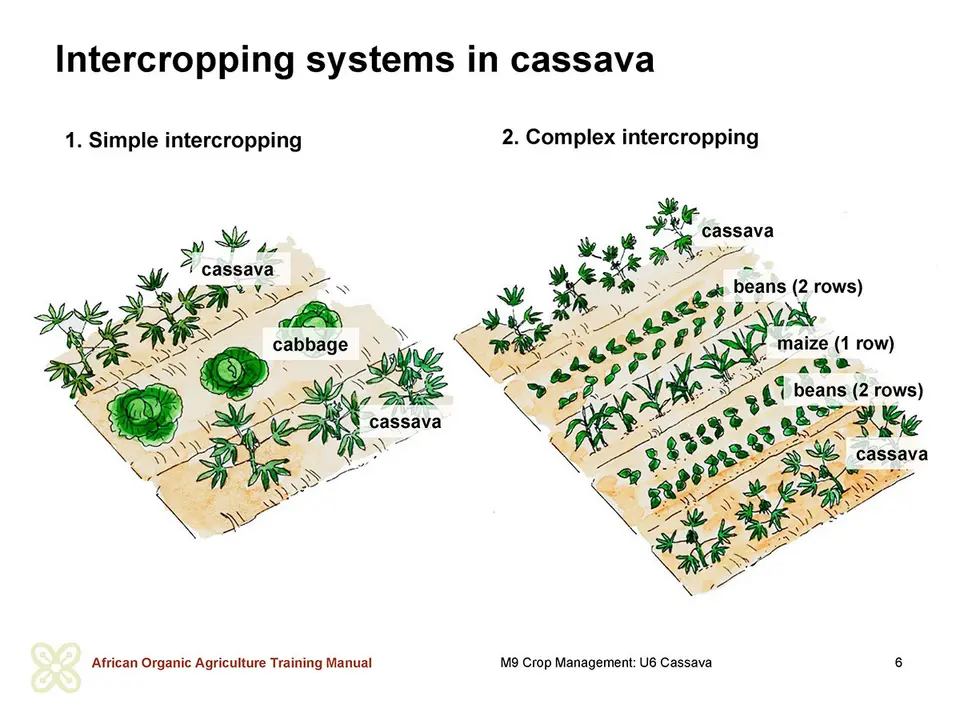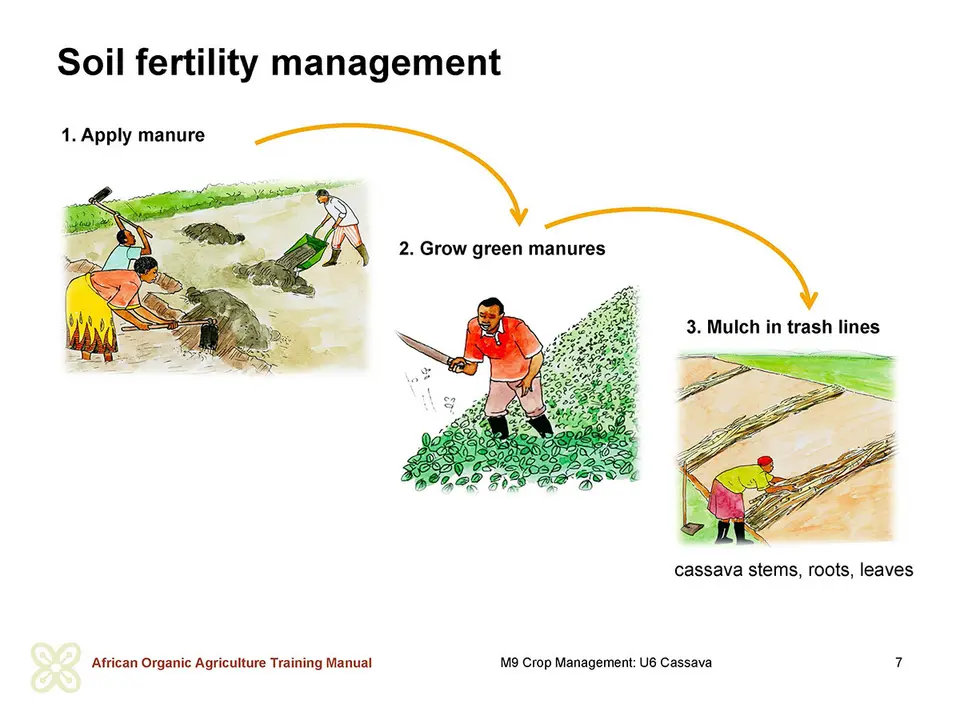Improving soil fertility
As already mentioned, cassava is known for its ability to produce good yields where other crops fail. This has led many farmers to believe that soil fertility is not important in cassava production. Experience and research have shown that this is a misconception. On the contrary, it is important to improve the nutrient availability of the soil by adding amounts of organic matter to the soil in order to maintain a good nutrient balance. This is particularly important at the early growth stage of cassava, as the root system of cassava develops slowly and has limited uptake. The type and quantities of fertilisers required by a cassava crop depend on several conditions, such as the type of soil.
Organic farmers use different strategies to improve soil fertility in cassava production. These strategies aim at preventing the loss of nutrients and organic matter on one hand and at maximizing the nutrient cycles on the other hand.
Working group on improving soil fertility
Organize working groups to discuss ways of improving soil fertility in cassava production. Let each working group discuss and formulate organic fertilization strategies for cassava that can be implemented according to the local conditions. They should include the advantages and disadvantages of each strategy recommended.
a. Returning cassava leaves and stems to the soil after harvest
Research has shown that below a yield of 15 kg per hectare, cassava removes much less nitrogen, phosphorus and potassium than most other crops. Each ton of fresh roots produced per hectare removes about 3 kg of nitrogen, 1 kg phosphorus and 7 kg potassium per hectare from the soil. This is because most nutrients, except K, are mainly present in cassava leaves and stems. Therefore, if leaves and stems are returned to the soil, nutrient removal will be minimal. However, in areas where leaves and stems are also utilized and removed from the field, nutrient removal will increase. In this case, nutrient depletion can become a serious concern if soil fertility is not maintained properly. Returning leaves and stems to the soil is an essential first step in preventing nutrient depletion and maintaining soil fertility. It is, therefore, important to avoid burning of cassava and other crop residues. The practice of burning crop residues is not allowed in organic agriculture.
b. Application of organic materials
Animal manure contains plant nutrients and improves the physical condition of the soil. The integration of farm animals can, therefore, contribute to better recycling of nutrients within the farm, if the animals are fed on farm-own forage legumes and the manure is returned to the field. Cassava plants will benefit from the valuable manure the cattle, sheep, goats, pigs or chicken offer. In order to minimize nutrient losses from manures, special attention must be paid to their collection, storage and application.
An interesting example of animal manure application is the ’Parcagem’ system in Brazil, which is also applicable in Africa.
The Brazilian ’Parcagem’ approach for plant nutrition
In Brazil very high yields of cassava have been obtained using the ’parcagem’ system. This system consists of in situ application of cattle manure, by leaving a high number of cattle overnight on a small area of land (30 animals per hectare during 60 nights) before planting cassava in the manured land.
Organic wastes such as kitchen wastes, animal manure and plant materials can also be collected, composted and applied to the cassava field to replenish the nutrients taken away through harvest. These materials improve the amount of nutrients as well as the soil organic matter content, and thus the soil’s physical conditions and water-holding capacity.
It is advisable to avoid using weed residues containing seeds, rhizomes, stolons, or tubers as mulch because these can increase weed problems on the farm. Also, straws of maize and guinea grass are bad mulch materials, as they take too long to rot and temporally reduce soil nitrogen before they are decomposed. In addition, organic farmers can also grow ’live mulches’. For example, egusi melon (a food crop), planted at very close spacing on cassava seedbeds is a good live mulch.
c. Green manuring
Planting of green manures and their subsequent mulching or incorporation into the soil before planting cassava is a traditional way to improve soil fertility. Leguminous crops such as cowpea (Vigna unguiculata), jack beans (Carnavalia ensiformis) or Crotalaria (C. ochroleuca G. Don.) make good green manure and have a significant beneficial effect on the subsequent yield of cassava. However, in many systems, cowpea has proved to be more promising. It can provide 80 kg of nitrogen per hectare to a subsequent crop in 8 to 10 weeks of growth. It is tolerant of drought and well-adapted to sandy and poor soils.
d. Crop rotation
The continuous planting of cassava in the same field year after year leads to increased disease and pest levels, reduced yields and crop failure. To avoid such development, organic farmers should wait for at least 2 years before planting cassava on the same field again and develop a crop rotation system. A rotation system generally improves soil fertility, reduces soil erosion and helps to control diseases and pests. The suitable crop rotation depends on several factors such as the climatic conditions, the market requirements and the skills and objectives of the farmer. However, within a pattern of crop rotation, cassava is often grown in sub-Saharan Africa at the end of the sequence, as it can still produce relatively well at lower fertility levels, where other crops would not grow well. This practice, however, leads to lower cassava yields. It is, therefore, important to establish a balanced crop rotation, which maintains or improves soil fertility, and to give cassava a place in the rotation that corresponds to farmer expectations. Cassava is a good crop to follow such crops as pumpkin, squashes, maize, sorghum or improved fallow. A 3-season rotation example that can be used in organic cassava production is maize-beans / cassava / groundnuts.


 tap and then scroll down to the Add to Home Screen command.
tap and then scroll down to the Add to Home Screen command.